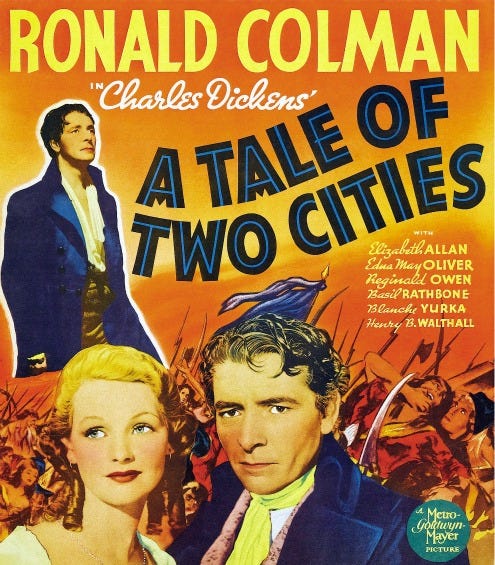A Tale of Two Cities (1935)

The 1935 version of "A Tale of Two Cities" is a movie stuck in time between two eras: Silent film and sound, theatricality and realism, literature and melodrama.
In the early years after the advent of sound, filmmakers were still figuring things out. The sound usually wasn't very good, evidenced by the disparity of levels at which dialogue and music were recorded. While watching the film, I found myself turning the volume up and down in order to hear what an actor was saying or to quiet the din of a rowdy crowd scene.
But film was still evolving from something based on the stage to an entirely new visual medium with its own language and style. Performers, who at this juncture almost invariably got their start on the stage, were still doing wild gesticulations and oversized facial expressions to "reach the back of the room." They were also learning to emote with their voices, unable to lean on title cards anymore, and sometimes they overdid it.
I think directors who got their start in the waning days of sound or after adjusted better than those like Jack Conway, who started directing in 1912. He stages his version of Charles Dickens' "A Tale of Two Cities" like a silent movie rather than a sound one, with static cameras and long takes where he lets his actors fume and pout and carry on.
The screenplay by W.P. Lipscomb and S.N. Behrman necessarily pares down the narrative to its core elements, but even at more than two hours the film feels like a Cliffs Notes version of the great novel. All the characters except Sydney Carton are more or less cardboard cutouts, though Madame DeFarge gets a fiery scene or two that stand out.
It's still a worthy movie if only for the sweep of Dickens' story of love and revolution, despair and revenge. And several of the big crowd scenes, especially the storming of the Bastille, are big-budget showstoppers with thousands of extras filling the frame in a way CGI still can't match.
Ronald Colman plays Carton, a brilliant barrister self-consciously throwing his life away on booze and self-interest who learns through his love of Lucie Manette (Elizabeth Allan) to make the ultimate sacrifice. The other characters — Lucie's father, Dr. Manette (Henry B. Walthall), her husband, Charles Darnay (Donald Woods), and her strident companion Miss Pross (Edna May Oliver) — fade into the background. Within the confines of the movie, they are mere facilitators of the plot.
A couple of exceptions to emerge. I quite enjoyed Blanche Yurka as Madame DeFarge, whose rage at the aristocrats boils over into a bloodthirsty need for revenge. Yurka was an opera star who branched over into the movies with this film in her late 40s and had a rather busy career thereafter.
Basil Rathbone also has a small but delectably cruel role as Charles Darnay's uncle, the Marquis de St. Evremonde, who regards oppressing the peasants as his natural birthright.
Interestingly, there had been two silent film versions of "A Tale of Two Cities" prior to this iteration, but only one version of any kind since — in 1958 starring Dirk Bogarde. I would say Dickens' novel is ripe for another adaptation, one that incorporates modern filmmaking styles with classic sensibilities.
4 Yaps



